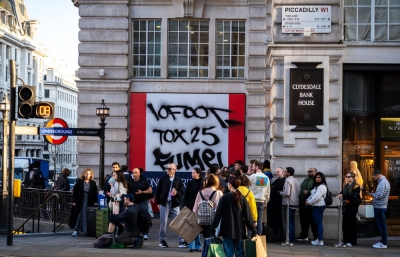“I want to take pictures of policemen kicking kids,” replied Tish Murtha, when asked why she wanted to take a Documentary Photography course at college. Needless to say, she was accepted. Murtha then honed her skills and began to document the area she came from and grew up in, Newcastle upon Tyne, North East England, an area struggling in the wake of an abrupt loss of industry and imposed purpose. One of her most acclaimed series,Youth Unemployment, accompanied by her 1980 essay, “Youth Unemployment in the West End of Newcastle,” sought to put pressure on both local and national government to respond to the unemployment crisis that was beginning to strip away the potential of an entire new generation of workers. “The sense of aimlessness and pent-up frustrations are reaching critical levels where they (the youth) will be transformed into an explosive anger, directed against the establishment that has been so careless of their hopes and needs.”
The early Thatcher-era was that of immense social change and radical opposition on the streets and within the art community, but that is not where Tish Murtha turned her camera. These weren’t political protestors: Murtha documented the day-to-day lives of her friends and family, lives that the establishment literally and figuratively kicked around. This was documentary photography from the inside, and while Murtha’s essay was a biting, blazing exposé on governmental responsibility for the conditions which a youth culture inherited, and the near inevitably that the city would fail if this generation were not cared for, the images themselves show a resourcefulness and a resilience, a strong and unwavering pulse. As an activist and artist, Murtha used her lens as a force against the notion that this was a generation undeserving of the job security that generations before had been afforded. 
What Youth Unemployment presented was the reality that these were people not without hopes, dreams or ambition, but a youth that the government was systematically failing. “Cuts in social spending, including unemployment benefits, mean that the conditions under which they must endure their enforced idleness will rapidly deteriorate to become an intolerable burden, the consequences of which will be enormous,” Murtha wrote. “Society has withdrawn its contract from these young people, can they now be expected to live by its rules? They see no real future for themselves, even the ‘right’ to earn a living is being replaced by a compulsory dependency on sub-human terms.”
There is the sense in these photos that this was the squandering of an entire generation. Murtha provided the perfect microscope into what was seen in a broader context in different corners of the industrial world in the late 1970s and early 1980s, where once grand cities turned to rubble and disrepair as a result of governmental abandonment. And yet, there is a beauty in these photographs, Murtha recognized the spirit of this disenfranchised youth, and captured their camaraderie and power with sensitivity and empathy. Although they may have been unemployed, they were bursting with potential. Murtha dedicated her life’s work to ensuring that the power, indeed, remained with the people. —Kim Stephens
Tish Murtha passed away unexpectedly from a brain aneurysm in 2013. Her daughter, Ella, is currently working on a documentary about her mother’s work, set to be released in 2023. Tish is also featured in BEYOND THE STREETS London, on view now at the Saatchi Gallery.
This article was originally published in the Spring 2023 Quarterly.




















